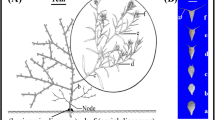Summary
Plasticity in life-history characteristics was investigated in three populations of Plantago major L. ssp. pleiosperma (Pilger), a self-compatible, wind pollinated species with a high self-fertilization rate. The populations studied were selected for their marked differences in biomass accumulation and habitat characteristics such as nutrient availability and interspecific interaction. Plants, raised from seeds collected at three sites, were grown in a greenhouse at three nutrient levels. In addition, a reciprocal transplant experiment was carried out. In both experiments variances in variables of growth and reproduction were largely due to environmental factors. Besides this overall result, population and population x environment interaction effects existed for most of the variables. Differences in plasticity between populations were further analysed. In the greenhouse experiment plants from a river-side population showed a high degree of plasticity in reproductive effort, whereas plants from two other populations, one series from a beach plain and the other from a salt meadow, showed a high degree of plasticity in shoot-root ratio. Plasticity in biomass allocation to either vegetative or generative parts is suggested to be an important response to selective forces related to either interspecific competition or temporal variability.
Similar content being viewed by others
References
Antonovics J, Primack RB (1982) Experimental ecological genetics in Plantago VI. The demography of seedling transplants of P. lanceolata. J Ecol 70:55–75
Blom CWPM (1983) Plasticity of life characteristics in two different populations of Plantago maritima L. Oecol Plant 4 (18):377–394
Bradshaw AD (1965) Evolutionary significance of phenotypic plasticity in plants. Adv Genet 13:115–155
Chapin FS III (1980) The mineral nutrition of wild plants. Ann Rev Ecol Syst 11:233–260
Hickman JC (1975) Environmental unpredictability and plastic energy allocation strategies in the annual Polygonum cascadese (Polygonaceae). J Ecol 63:687–701
Kuiper D (1982) Genetic differentiation in Plantago major: Ca2+-and Mg2+-stimulated ATPases from roots and their role in phenotypic adaptation. Physiol Plant 56:436–443
Kuiper D (1983) Genetic differentiation in Plantago major: Growth and root respiration and their role in phenotypic adaptation. Physiol Plant 57:222–230
Lacey EP, Real L, Antonovics J, Heckel DG (1983) Variance models in the study of life bistories. Am Nat 122:114–131
Mølgaard P (1976) Plantago major ssp. major and ssp. pleiosperma: Morphology, biology and ecology in Denmark. Bot Tidsskr 71:31–56
Miller RG (1981) Simultaneous statistical inference. Second edition. Springer, New York
Nie NH, Hull CH (1981) SPSS update 7–9: New procedures and facilities for releases. McGraw-Hill, New York
Poorter H, Lambers H (in prep) Growth and competitive ability of a highly plastic and a marginally plastic genotype of Plantago major in a fluctuating environment
Primack RB, Antonovics J (1981) Experimental ecological genetics in Plantago V. Components of seed yield in the ribwort plantain Plantago lanceolata L. Evolution 35:1069–1079
Schmitt J (1983) Individual flowering phenology, plant size, and reproductive success in Linanthus androsaceus, a California annual. Oecologia (Berlin) 59:135–140
Smakman G, Hofstra JJ (1982) Energy metabolism of Plantago lanceolata, as affected by change in root temperature. Physiol Plant 56:33–37
Soule JD, Werner PA (1981) Patterns of resource allocation in plants, with special reference to Potentilla recta. L Bull Torrey Bot Club 108:311–319
Stearns SC (1977) The evolution of life history traits: A critique of the theory and a review of the data. Ann Rev Ecol Syst 8:145–171
Troelstra SR (1983) Growth of Plantago lanceolata and Plantago major on a NO3/NH4 medium and the estimation of the utilization of nitrate and ammonium from ionic-balance aspects. Plant and Soil 76:183–197
Troelstra SR, Sluimer L, Smant W, Wagenaar R, Van der Meulen MA (1981) On the soil chemistry of natural habitats of Plantago species and Hypochaeris radicata in various parts of the Netherlands in relation to the chemical composition of the plants. Verh Kon Ned Akad Wetensch, Afd Naturkunde II 77, Progress Report IOO:20–32
Troelstra SR, Smant W, Wagenaar R (1983) Different K and P requirements for Plantago major ssp. major and Plantago lanceolata? Verk Kon Ned Akad Wetensch, Afd Natuurk II 81, Progress Report IOO: 43–54
Van Dijk H (1984) Genetic variability in Plantago species in relation to their ecology. II Quantitive characters and allozyme loci in P. major. Theor Appl Genet 68:43–52
Van Dijk H, Van Delden W (1981) Genetic variability in Plantago species in relation to their ecology, I Genetic analysis of the allozyme variation in P. major subspecies. Theor Appl Genet 60:285–290
Author information
Authors and Affiliations
Rights and permissions
About this article
Cite this article
Lotz, L.A.P., Blom, C.W.P.M. Plasticity in life-history traits of Plantago major L. ssp. pleiosperma Pilger. Oecologia 69, 25–30 (1986). https://doi.org/10.1007/BF00399033
Received:
Issue Date:
DOI: https://doi.org/10.1007/BF00399033




